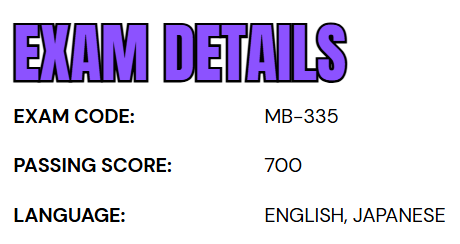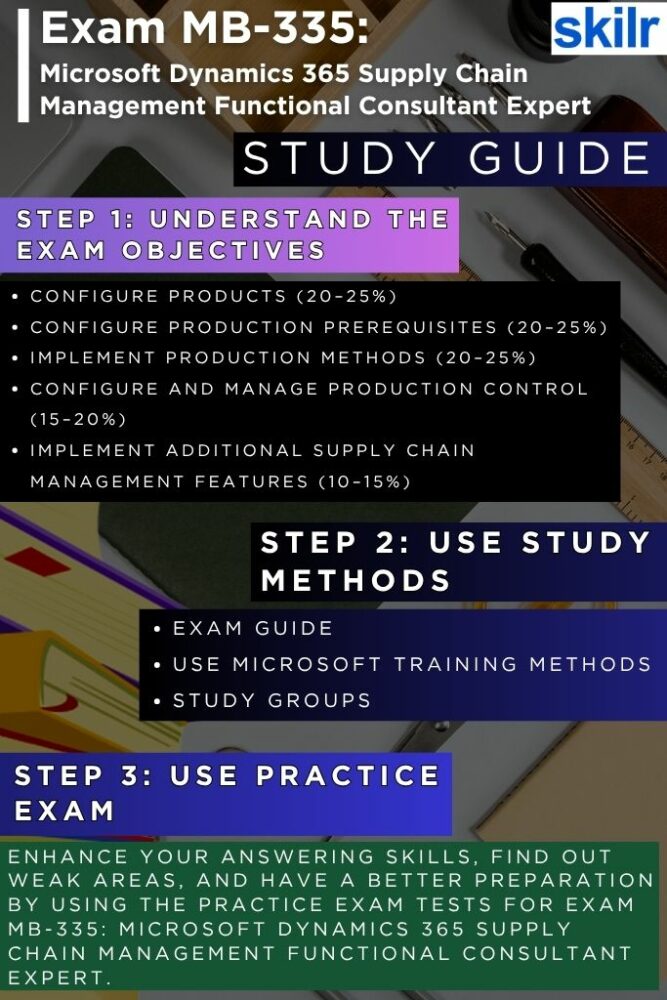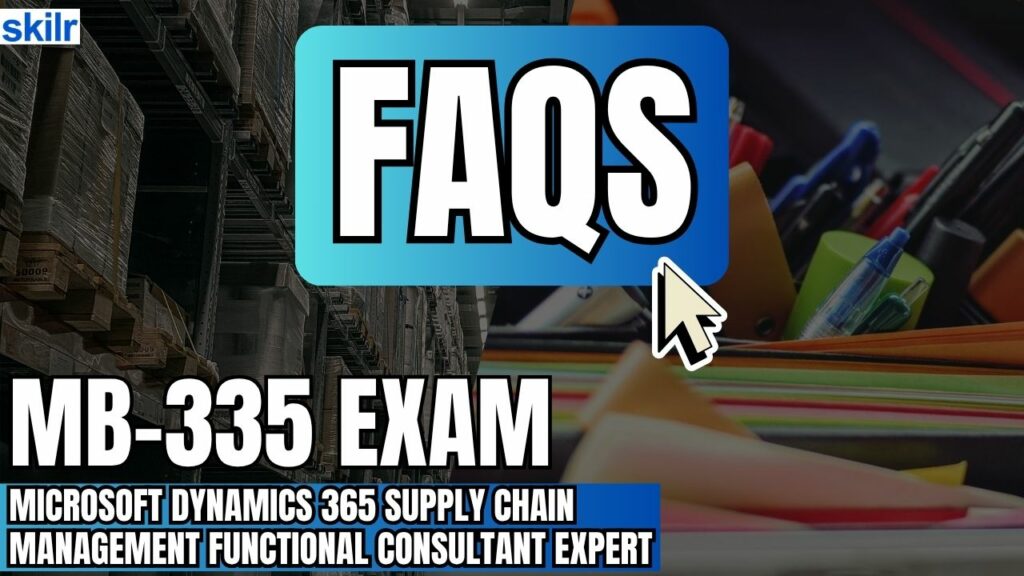
The MB-335 certification exam is designed for professionals who serve as senior or expert-level functional consultants in the field of supply chain management. These individuals are responsible for implementing and configuring advanced capabilities within Microsoft Dynamics 365 Supply Chain Management, aligning the platform’s features with specific business needs. Qualified candidates are expected to demonstrate in-depth knowledge across a wide range of operational domains, including:
- Production Management
- Logistics and Distribution
- Master Planning & Planning Optimization
- Advanced Functionalities such as:
- Mixed Reality Integration
- Microsoft Copilot Features within Dynamics 365
- Extended Supply Chain Processes like:
- Rebate Management
- Service Management
– Primary Responsibilities
As a certified functional consultant, your role involves:
- Evaluating Business Requirements
- Translating Requirements into Functional Solutions and Processes
- Adopting Industry Best Practices to ensure successful implementations
You are expected to take ownership of delivering high-impact solutions that address real-world operational challenges.
– Manufacturing Methodologies
Candidates must be proficient in at least one of the following manufacturing strategies:
- Discrete Manufacturing
- Process Manufacturing
- Lean Manufacturing
This ensures that you can tailor solutions based on the specific production methodologies used by the organization.
– Collaboration and Implementation
To deliver effective solutions, you collaborate closely with a range of stakeholders, including:
- Solution Architects
- Technical Developers
- Functional Consultants
- Business Stakeholders
Exam Details

The MB-335 exam is available in English and Japanese. To successfully pass the exam, candidates must achieve a minimum score of 700. Microsoft provides accommodations for individuals who require additional support during the exam. If you use assistive technology, need extra time, or require any modifications to the standard exam experience, you may submit a request for accommodations through the official Microsoft certification support process.
Course Outline
The exam covers the following topics:
1. Configuring products (20–25%)
Implementing advanced product information features
- Configuring formula items, planning items, co-products, and by-products (Microsoft Documentation: About co-products and by-products)
- Configuring catch weight items including handling policies (Microsoft Documentation: Catch weight product processing with warehouse management)
- Configuring inventory batches, batch attributes, and lot inheritance (Microsoft Documentation: Add batch attribute values to an inventory batch, About lot inheritance)
- Managing product compliance including regulated and restricted items
- Create and implement configuration groups and routes for dimension-based products (Microsoft Documentation: Dimension-based product configuration overview)
- Manage products with dimension-based configurations
- Configure advanced export control functionality, excluding Power Fx formulas (Microsoft Documentation: Advanced export management overview)
- Configuring and managing hazardous materials (Microsoft Documentation: Set up hazardous materials)
Implementing constraint-based product configuration models
- Creating and managing product configuration model components and subcomponents (Microsoft Documentation: Create a product configuration model)
- Creating calculations for product configuration models, including configuration using tables and/or expressions (Microsoft Documentation: Product configuration model calculations)
- Configuring BOM lines and route operations for a product configuration model (Microsoft Documentation: Product configuration overview)
- Configuring and managing pricing for configuration models (Microsoft Documentation: Maintain sales prices for product configuration models)
- Validate, approve, and test product configuration models
Implementing engineering change management
- Designing an engineering product lifecycle (Microsoft Documentation: Product lifecycle state overview)
- Configuring engineering categories (Microsoft Documentation: Engineering change management feature walkthrough)
- Configuring product readiness policies and product release policies (Microsoft Documentation: Product readiness checks)
- Creating an engineering product with engineering attributes
- Releasing engineering products to a local company (Microsoft Documentation: Release product structures)
- Scheduling and implementing engineering change requests and change orders (Microsoft Documentation: Manage changes to engineering products)
2. Configuring production prerequisites (20-25%)
Configuring resources, routes, and calendars
- Implementing and managing work calendars and working time (Microsoft Documentation: Create a working time calendar)
- Creating and configuring resource capabilities (Microsoft Documentation: Define resource capabilities)
- Implementing and managing resources and resource groups
- Creating and managing operations and routes, including routes to manage scrap (Microsoft Documentation: Routes and operations)
Configuring production settings and processes
- Creating production units, production groups, production pools, and production journal names (Microsoft Documentation: Set up a production unit, Create production pools)
- Managing reservations in production process, including partial reservations and re-reservations
- Configuring warehouse processes for raw materials picking and finished goods put away (Microsoft Documentation: Set up production processes in a warehouse)
- Designing a unified (mixed mode) manufacturing process (Microsoft Documentation: Mixed mode planning – Combine discrete, process, and lean sourcing)
- Configuring production control parameters (Microsoft Documentation: Set up production control parameters)
Implementing costing
- Configuring costing sheets and indirect costs (Microsoft Documentation: About costing sheet setup)
- Configuring and managing cost groups, costing versions, and cost categories (Microsoft Documentation: Costing versions overview, Cost categories used in production routing)
- Configuring cost allocations for co-products and burden allocation for by-products
- Configuring and performing BOM/formula calculations (Microsoft Documentation: BOM calculations)
- Calculating and activating item cost prices (Microsoft Documentation: Update standard costs for a new manufactured item)
- Configuring production posting profiles (Microsoft Documentation: Posting profiles overview)
- Analyzing common sources of production variances
- Viewing and analyzing production and inventory costs
3. Implementing production methods (20–25%)
Applying discrete manufacturing
- Managing production order lifecycle stages including create, estimate, schedule, release, start
- Creating and processing picking list journals (Microsoft Documentation: About production journals)
- Creating and processing job card and route card journals
- Creating and processing reports as finished journals (Microsoft Documentation: Report production orders as finished)
- Reset the status of a production order (Microsoft Documentation: About reversing production order status)
- Configuring and managing production-related reservations
- Configure bills of material (BOM) and BOM versions (Microsoft Documentation: Bills of materials and formulas)
- Manage production order lifecycle stages including report as finished and end
- Configure and use mobile device to start, report as finish, and register material consumption in production
- Configure error quantity posting using allocation or ledger account in production
- Substitute materials in the manufacturing process
Implementing process manufacturing
- Configuring batch reservations and release to warehouse process (Microsoft Documentation: Release to warehouse)
- Configuring consolidated batch order processes (Microsoft Documentation: Firm a consolidated batch order)
- Managing batch balancing and batch order sequencing (Microsoft Documentation: Batch balancing)
- Configuring formulas features
- Creating and processing report as finished journals with co-products and by-products (Microsoft Documentation: About co-products and by-products)
- Creating and processing batch orders and a rework batch order (Microsoft Documentation: Create a rework batch order)
- Configuring formulas and formula versions
Implementing lean manufacturing
- Creating value streams and production flows (Microsoft Documentation: Create a value stream)
- Creating kanban rules
- Processing and managing kanban orders by using kanban boards (Microsoft Documentation: Execute kanban process jobs)
4. Configuring and managing production control (15–20%)
Implementing subcontracting
- Implementing subcontracting for discrete and process manufacturing (Microsoft Documentation: Manage subcontracting work in production)
- Configuring BOM and formula lines, resources, and routes for subcontracting items (Microsoft Documentation: Bills of materials and formulas)
- Managing service items and prices for subcontracting
- Create and process subcontracting purchase orders (Microsoft Documentation: Subcontract purchase orders overview)
- Creating and processing transfer orders for subcontracting
Implementing manufacturing execution
- Configuring time and attendance prerequisites and activate workers for time registration (Microsoft Documentation: Enable workers to register time and attendance)
- Configuring manufacturing execution features including production floor execution interface (Microsoft Documentation: Manufacturing execution systems integration)
- Process production and batch orders by using production floor execution interface (Microsoft Documentation: Production process overview, Configure the production floor execution interface)
- Calculate and approve time registrations (Microsoft Documentation: Calculate, approve, and transfer registrations)
Implementing production scheduling and capacity planning
- Configuring scheduling parameters (Microsoft Documentation: Configure scheduling parameters)
- View, monitor, and update production schedules (Microsoft Documentation: Service update availability)
- Configuring capacity for production resources including machines, labor, and tooling (Microsoft Documentation: Operations resources)
- Configuring infinite and finite scheduling and capacity (Microsoft Documentation: Finite capacity planning and scheduling)
- Set up and run operations and job scheduling (Microsoft Documentation: Job scheduling)
- Configuring and using Gantt to schedule production jobs
5. Implementing additional supply chain management features (10–15%)
Implementing Rebate management
- Configuring Rebate management parameters (Microsoft Documentation: Rebate management parameters)
- Managing rebate reduction principles (Microsoft Documentation: Rebate reduction principles)
- Process, review, and post rebates (Microsoft Documentation: Process, review, and post rebates)
Implementing advanced master planning scenarios
- Evaluating and processing planned production and kanban orders
- Configuring intercompany master planning (Microsoft Documentation: Intercompany planning)
- Configuring forecast models, plans, and parameters (Microsoft Documentation: Configure forecasts in your organization)
- Running demand forecasting and adjust as appropriate (Microsoft Documentation: Demand forecasting setup)
- Executing explosion and validate results (Microsoft Documentation: Use tracing for explosion)
- Configuring supply chain calendars
- Configuring Demand Driven Material Requirements Planning (DDMRP) (Microsoft Documentation: Demand Driven Material Requirements Planning (DDMRP) overview)
- Configuring the Planning Optimization Add-in for Microsoft Dynamics 365 Supply Chain Management (Microsoft Documentation: Get started with master planning)
- Creating and managing forecasting
Microsoft MB-335 Exam FAQs
Microsoft Certification Exam Policies
Microsoft upholds a well-defined and transparent set of certification exam policies to ensure fairness, consistency, and integrity across its certification process. These policies are applicable to all delivery methods, including online proctored exams and those administered at authorized testing centers.
- Exam Retake Policy
- If a candidate does not pass an exam on the first attempt, a minimum waiting period of 24 hours is required before retaking it. For all subsequent attempts, a mandatory waiting period of 14 days must be observed between each attempt. Microsoft allows a maximum of five exam attempts within a 12-month period. Once an exam is passed, no additional retakes are permitted unless the related certification expires and needs to be renewed. Each retake is subject to the standard exam fee.
- Rescheduling and Cancellation Policy
- Candidates may reschedule or cancel their exam appointments without penalty if changes are made at least six business days before the scheduled exam date. Rescheduling or cancellations made within five business days may incur a fee. If a candidate cancels within 24 hours of the scheduled time or fails to appear for the exam, the full exam fee will be forfeited.
Microsoft MB-335 Exam Study Guide

Step 1: Understand the Exam Objectives
Begin your preparation by thoroughly reviewing the official exam objectives published by Microsoft. These outline the core functional areas the exam will assess, such as product information management, procurement and sourcing, inventory management, production control, and supply chain processes. Understanding these domains will help you identify the key skills you need to focus on and will serve as a roadmap for your study plan.
Step 2: Explore Official Microsoft Learning Paths
Microsoft offers comprehensive self-paced learning paths on Microsoft Learn, which are an excellent starting point. These modules are structured, interactive, and cover all necessary concepts with practical examples and hands-on labs. The modules are:
- Configuring and managing products and inventory in Dynamics 365 Supply Chain Management
- Configuring and using discrete manufacturing in Dynamics 365 Supply Chain Management
- Configuring and using process manufacturing in Dynamics 365 Supply Chain Management
- Setting up engineering change management for Dynamics 365 Supply Chain Management
- Managing product version information in Dynamics 365 Supply Chain Management
- Configuring and using lean manufacturing in Dynamics 365 Supply Chain Management
- Using warehouse management in manufacturing in Dynamics 365 Supply Chain Management
- Configuring Asset Management for Dynamics 365 Supply Chain Management
- Working with Asset Management for Dynamics 365 Supply Chain Management
- Configuring and managing procurement and vendors in Dynamics 365 Supply Chain Management
- Configuring and managing sales, and customers in Dynamics 365 Supply Chain Management
- Master planning in Dynamics 365 Supply Chain Management
For a more guided approach, consider enrolling in instructor-led training courses from Microsoft Learning Partners. This course builds advanced skills in Microsoft Dynamics 365 Supply Chain Management, covering key areas like inventory, procurement, production, asset management, transportation, and warehouse management. It includes hands-on, scenario-based exercises to reinforce learning. Designed for functional consultants, this course is ideal for professionals who configure and implement advanced supply chain features, translate business needs into solutions, and work with technologies like IoT, ML, and mixed reality within Dynamics 365.
Step 3: Join Microsoft and Community Study Groups
Engaging with others, preparing for the MB-335 exam can significantly enhance your understanding. Join official Microsoft Tech Community forums, LinkedIn groups, or dedicated Discord/Reddit communities. These platforms allow you to share resources, ask questions, and gain insights from peers and professionals who have already passed the exam. Collaborative learning often reveals perspectives and use cases you may not have encountered alone.
Step 4: Apply Knowledge Through Practical Experience
Hands-on experience with Dynamics 365 Supply Chain Management is crucial. Set up a trial environment using Microsoft Dynamics 365 Finance and Operations or access labs provided in official training to simulate real-world business scenarios. This practical exposure helps reinforce theoretical knowledge and prepares you for the application-based nature of the exam questions.
Step 5: Use Microsoft MB-335 Exam Practice Tests
Once you’ve covered the learning material, assess your readiness by taking official Microsoft practice exams or reputable third-party mock tests designed specifically for the MB-335 exam. These tests simulate the exam format and timing, helping you identify weak areas and improve your time management. Review explanations for both correct and incorrect answers to strengthen your conceptual clarity.
Step 6: Review and Reinforce Key Concepts
In the final phase of your preparation, revisit complex topics and reinforce your understanding using flashcards, summary notes, or video tutorials. Pay special attention to areas where you scored lower in practice exams. Use scenario-based questions to challenge your comprehension and simulate how you would apply knowledge in real business situations.
Step 7: Final Exam Readiness Check
Before booking your exam, ensure you’re consistently scoring well in mock tests and feel confident across all functional areas. Revisit the exam guide once more to cross-check that all objectives have been covered. Confirm exam logistics, such as system requirements (if testing online) and ID requirements, to avoid any last-minute issues.


